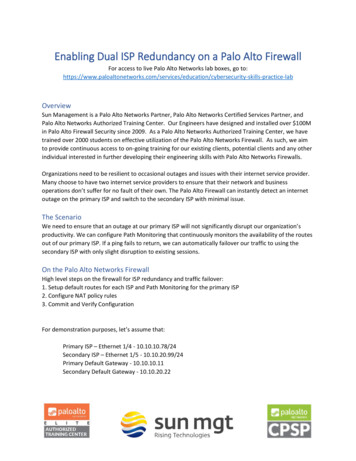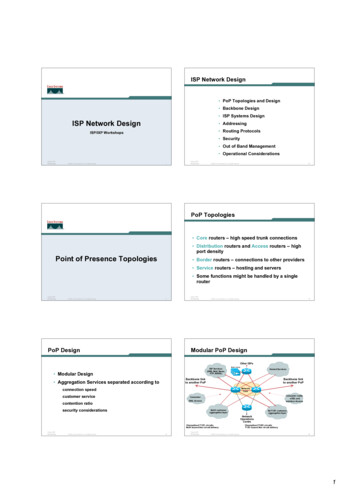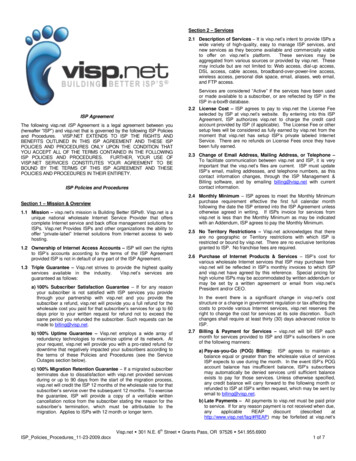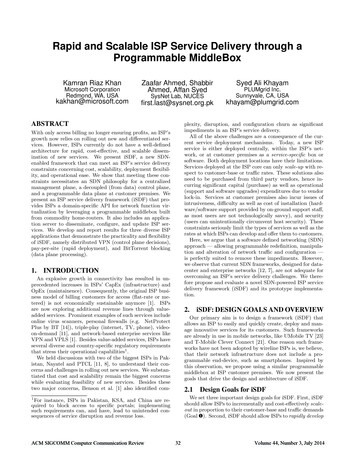
Transcription
Enabling Dual ISP Redundancy on a Palo Alto FirewallFor access to live Palo Alto Networks lab boxes, go tion/cybersecurity-skills-practice-labOverviewSun Management is a Palo Alto Networks Partner, Palo Alto Networks Certified Services Partner, andPalo Alto Networks Authorized Training Center. Our Engineers have designed and installed over 100Min Palo Alto Firewall Security since 2009. As a Palo Alto Networks Authorized Training Center, we havetrained over 2000 students on effective utilization of the Palo Alto Networks Firewall. As such, we aimto provide continuous access to on-going training for our existing clients, potential clients and any otherindividual interested in further developing their engineering skills with Palo Alto Networks Firewalls.Organizations need to be resilient to occasional outages and issues with their internet service provider.Many choose to have two internet service providers to ensure that their network and businessoperations don’t suffer for no fault of their own. The Palo Alto Firewall can instantly detect an internetoutage on the primary ISP and switch to the secondary ISP with minimal issue.The ScenarioWe need to ensure that an outage at our primary ISP will not significantly disrupt our organization’sproductivity. We can configure Path Monitoring that continuously monitors the availability of the routesout of our primary ISP. If a ping fails to return, we can automatically failover our traffic to using thesecondary ISP with only slight disruption to existing sessions.On the Palo Alto Networks FirewallHigh level steps on the firewall for ISP redundancy and traffic failover:1. Setup default routes for each ISP and Path Monitoring for the primary ISP2. Configure NAT policy rules3. Commit and Verify ConfigurationFor demonstration purposes, let’s assume that:Primary ISP – Ethernet 1/4 - 10.10.10.78/24Secondary ISP – Ethernet 1/5 - 10.10.20.99/24Primary Default Gateway - 10.10.10.11Secondary Default Gateway - 10.10.20.22
1. Default Routes and Path MonitoringLet’s start by setting up our primary default route and path monitoring.Name: Primary-DefaultDestination: 0.0.0.0/0Interface: ethernet1/4Next Hop: IP Address 10.10.10.11Now that we have the default route, let’s configure path monitoring for this route.Name: Primary-Default-GatewaySource IP: 10.10.10.78/24 – (The address block we have for our Primary ISP)Destination: 10.10.10.11 – (Our default gateway)We can hypothetically ping anything on the internet to monitor this path, but let’s stick to the defaultgateway.
Let’s configure our secondary route. We’ll make sure to give this route a higher metric so that it’s onlyused if the primary route is deemed inaccessible.
Now that this is configured, if a ping fails to return, the primary route will be removed from the routingtable and the secondary route will be active. If the firewall finds that the primary path has returnedpings for 60 seconds, it will once again become the active route.2. NAT ConfigurationWe want to ensure that we are translating to the correct public IP based on which interface and ISP weare using. Both internet providers have been placed in the same security zone, for further networksegmentation, we could create a zone for each provider.3. Commit and VerifyNow, we’ll commit our changes. In the top right, we’ll hit “Commit to Device”Once that is complete, we can go to our routing table and verify the path monitoring. The Static RouteMonitoring tab will tell us that status of our monitored route. Below is the instance in which the path isdown and the primary route has been taken out of the routing table so that the secondary route may beused.
Next StepsIf you want to implement this in your environment and would be more comfortable having someonewith experience help you in the process, contact your Sun Management account rep to schedule one ofour certified Palo Alto Networks engineers to assist with setting up ISP redundancy on the firewall.If you want to test this on your own and do not have access to a lab environment to do so, contact yourSun Management account rep to get pricing on a lab bundle. The PA-220 and VM-50 appliances areexcellent platforms for testing things such as this and there are specific part numbers for lab equipmentthat are more heavily discounted than the same appliance for use in production.Sun ManagementSun Management is a Value Added Reseller (VAR) focusing on Network and Internetwork SecurityRequirements. We work primarily in the Mid Atlantic area: Maryland (MD), Virginia (VA), District ofColumbia (DC), West Virginia (WV), Delaware (DE) and Pennsylvania (PA). Our credentials include PaloAlto Networks Services Provider, Palo Alto Networks Certified Training Partner, and Palo Alto NetworksCertified Managed Security Service Provider (MSSP) using CORTEX XSOAR in a multi-tenantenvironment.We address requirements concerning Network Detection and Response (NDR); internal and external TLSand SSL requirements for complete data visibility; End Point Detection and Response (EDR); GrammLeach Bliley Act, HIPPA, Sarbanes Oaxley and PCI DSS; penetration testing and firewall optimization; andData Protection by tracking all Data Flows within the network, across applications, betweenusers/servers and in the cloud. Contact us at (888) 773-9422 to setup a POC or if you just want moreResource CSArticleDetail?id s/configure-pathmonitoring-for-a-static-route.html
On the Palo Alto Networks Firewall High level steps on the firewall for ISP redundancy and traffic failover: 1. Setup default routes for each ISP and Path Monitoring for the primary ISP 2. Configure NAT policy rules 3. Commit and Verify Configuration For demonstration purposes, let's assume that: Primary ISP - Ethernet 1/4 - 10.10.10.78/24










